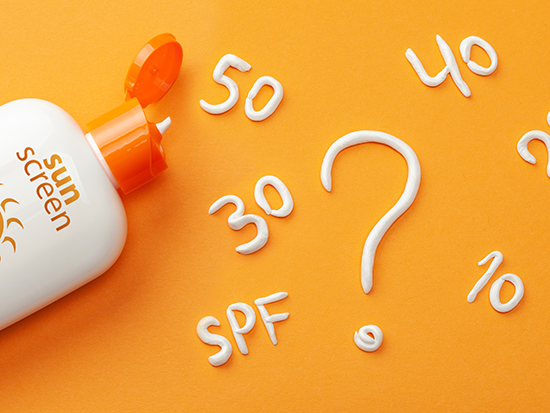Skin cancer protection: Experts walk through the life cycle of sun exposure

As sunny days and summer approach, skin care and sunscreen are more important than ever. Avoiding ultraviolet light can potentially prevent nearly 3 million cases of skin cancer annually.
Lauren Kole, M.D., associate professor in the University of Alabama at Birmingham’s Department of Dermatology, says sunscreen is the first step in skin protection and encourages all individuals to get regularly checked by a dermatologist.
“One in four people will have skin cancer by the age of 67,” Kole said. “Even those in their 20s and 30s should get checked if they have had significant sun exposure.”
Pre-Sun Exposure
Sun protection factor, commonly known as SPF, is the first factor Kole recommends the buyer look at when choosing a sunscreen. The American Academy of Dermatology recommends using a sunscreen with 30 SPF or higher. While sunscreen is not guaranteed to block 100 percent of UV rays, Kole says a 30 SPF will block around 97 percent.
“Using a 30 SPF or higher sunscreen daily is a must, whether you spend your days indoors or outdoors,” Kole said. “The sunscreen in makeup is a bonus, but is not enough on its own.”
A broad-spectrum sunscreen is also recommended as it can help protect against both UV rays and UVB rays. UV rays can cause premature aging, and UVB rays cause sunburn. Both types of rays can lead to skin cancer.
Kole recommends a water-resistant sunscreen in the summer due to an increase in excess sweating and water activities.
Sunscreens can be found in many different forms, such as spray, cream, gel and stick. Kole breaks down the benefits of each type that consumers should consider before buying.
- Spray sunscreen is popular due to its easy application. However, people often do not apply enough of this product to properly protect the skin. Sprays are also harder to control around the face, making it easier to ingest or inhale the product, which can be harmful.
- Cream sunscreens take longer to apply but can be applied almost everywhere on the body, including the face. A primary benefit of cream sunscreen is that people tend to apply more of this product compared to a spray sunscreen.
- Stick sunscreens are not great for whole body application but are perfect for safe application to the facial area. Many of the facial focused sunscreens include moisturizing and antiaging ingredients, which are helpful when individuals are in the sun for an extended period.
- Gel sunscreens are proven to be the most effective around areas that have a lot of hair, such as the scalp. Powder sunscreens can also be an asset in scalp protection.
Kole says it is important to ensure a sunscreen is FDA-approved before purchasing. Look for the ingredients zinc oxide and titanium dioxide as they are proven to be safe and effective for sunscreen use. She encourages people to avoid sunscreens that contain aminobenzoic acid and trolamine salicylate because the FDA does not consider them effective or safe for sunscreen.
Sunscreens do expire, so it is important to keep track of those expiration dates and replace them when necessary. Kole says that, if a sunscreen product does not have an expiration date, it should be considered no longer effective three years after purchase.
Application
Proper application is crucial in skin protection. Kole suggests applying sunscreen 15 minutes before going outside for the most effective use. This will allow the sunscreen to form a protective barrier by fully absorbing into the skin.
Sunscreen is not guaranteed to protect the skin all day, so it is important to reapply. Kole recommends reapplying every two hours and after excess swimming and sweating.
During application, it is easy to miss areas individuals cannot see or reach. Kole suggests having someone help apply sunscreen to the hard-to-reach areas such as the upper back and shoulders, or make sure these areas are covered.
Sunscreen should not be replaced with tanning oil or lotion, and extra sun-protection measures such as wearing hats and sunglasses are recommended.
Spending time in the sun all day or during peak sunlight hours is not recommended by experts. People should be aware of the sun’s peak times of intensity and limit their amount of sun exposure during those times.
After Sun Exposure
If sunburn does occur, Kole says taking a cool bath, applying moisturizers and drinking plenty of water are good post-sun-exposure practices. She recommends using a hydrocortisone cream because it can help ease sunburn discomfort.
Experts urge people to avoid products ending in -cain, such as lidocaine. Although products such as lidocaine reduce the burn pain, they do not treat the underlying skin damage. With any sunburn, avoid the sun while the skin heals, and be sure to cover the sunburned areas when outside.
Severe cases of sunburn may lead to sun poisoning, which will need to be treated by a health care professional. According to Healthline, sun poisoning symptoms include:
- Peeling or blistering skin
- Fever
- Dehydration
- Severe redness or pain
- Nausea
- Headaches
- Confusion, dizziness or fainting
Individuals should also check regularly for spots or changes in their skin and see a dermatologist if they notice the following:
- Pigmented spots greater than the diameter of a pencil eraser
- Spots with a variety of colors
- Spots that have irregular borders
- Spots or patches that change over time (e.g., growing, bleeding or itching)
Make an appointment with UAB Dermatology today.




